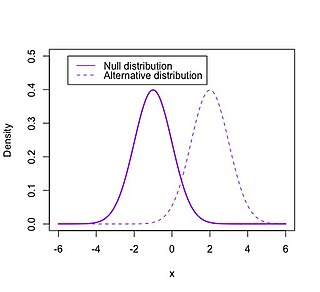在推論統計學中,零假設(英語:Null hypothesis,又譯零假說,符號:)是做統計檢驗時的一類假說。
此條目可參照英語維基百科相應條目來擴充。 (2024年5月29日) |

零假設的內容一般是希望能證明為錯誤的假設,與零假設相對的是對立假說,即希望通過證偽零假設而證明正確的另一種假說。從數學上來看,零假設和備擇假設的地位是相等的,但是在統計學的實際運用中,常常需要強調一類假設為應當或期望實現的假設,例如在相關性檢驗中,一般會取「兩者之間無關聯」作為零假設,而在獨立性檢驗中,一般會取「兩者之間非獨立」作為零假設。
如果一個統計檢驗的結果拒絕(reject)零假設(結論不支持零假設),而實際上真實的情況屬於零假設,那麼稱這個檢驗犯了型一錯誤。反之,如果檢驗結果支持零假設,而實際上真實的情況屬於備擇假設,那麼稱這個檢驗犯了型二錯誤。通常的做法是,在保持第一類錯誤出現的機會在某個特定水平上的時候(即顯著性差異值或α值),儘量減少第二類錯誤出現的概率。
相關條目
參考來源
延伸閱讀
- Adèr, H. J.; Mellenbergh, G. J. & Hand, D. J. Advising on research methods: A consultant's companion. Huizen, The Netherlands: Johannes van Kessel Publishing. 2007. ISBN 90-79418-01-3.
- Efron, B. Large-Scale Simultaneous Hypothesis Testing. Journal of the American Statistical Association. 2004, 99 (465): 96. doi:10.1198/016214504000000089. The application of significance testing in this paper is an outlier. Tests to find a null hypothesis? Not trying to show significance, but to find interesting cases?
- Rice, William R.; Gaines, Steven D. 'Heads I win, tails you lose': testing directional alternative hypotheses in ecological and evolutionary research. TREE. June 1994, 9 (6): 235–237. doi:10.1016/0169-5347(94)90258-5. Directed tests combine the attributes of one-tailed and two-tailed tests. "...directed tests should be used in virtually all applications where one-sided tests have previously been used, excepting those cases where the data can only deviate from H0, in one direction."
外部連結
Wikiwand in your browser!
Seamless Wikipedia browsing. On steroids.
Every time you click a link to Wikipedia, Wiktionary or Wikiquote in your browser's search results, it will show the modern Wikiwand interface.
Wikiwand extension is a five stars, simple, with minimum permission required to keep your browsing private, safe and transparent.

